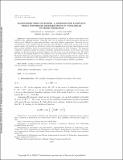Randomize-Then-Optimize: A Method for Sampling from Posterior Distributions in Nonlinear Inverse Problems
Author(s)
Bardsley, Johnathan M.; Solonen, Antti; Haario, Heikki; Laine, Marko
DownloadBardsley-2014-RANDOMIZE-THEN-OPTIM.pdf (653.9Kb)
PUBLISHER_POLICY
Publisher Policy
Article is made available in accordance with the publisher's policy and may be subject to US copyright law. Please refer to the publisher's site for terms of use.
Terms of use
Metadata
Show full item recordAbstract
High-dimensional inverse problems present a challenge for Markov chain Monte Carlo (MCMC)-type sampling schemes. Typically, they rely on finding an efficient proposal distribution, which can be difficult for large-scale problems, even with adaptive approaches. Moreover, the autocorrelations of the samples typically increase with dimension, which leads to the need for long sample chains. We present an alternative method for sampling from posterior distributions in nonlinear inverse problems, when the measurement error and prior are both Gaussian. The approach computes a candidate sample by solving a stochastic optimization problem. In the linear case, these samples are directly from the posterior density, but this is not so in the nonlinear case. We derive the form of the sample density in the nonlinear case, and then show how to use it within both a Metropolis--Hastings and importance sampling framework to obtain samples from the posterior distribution of the parameters. We demonstrate, with various small- and medium-scale problems, that randomize-then-optimize can be efficient compared to standard adaptive MCMC algorithms.
Date issued
2014-08Department
Massachusetts Institute of Technology. Department of Aeronautics and AstronauticsJournal
SIAM Journal on Scientific Computing
Publisher
Society for Industrial and Applied Mathematics
Citation
Bardsley, Johnathan M., Antti Solonen, Heikki Haario, and Marko Laine. “Randomize-Then-Optimize: A Method for Sampling from Posterior Distributions in Nonlinear Inverse Problems.” SIAM Journal on Scientific Computing 36, no. 4 (January 2014): A1895–A1910. © 2014 Society for Industrial and Applied Mathematics
Version: Final published version
ISSN
1064-8275
1095-7197